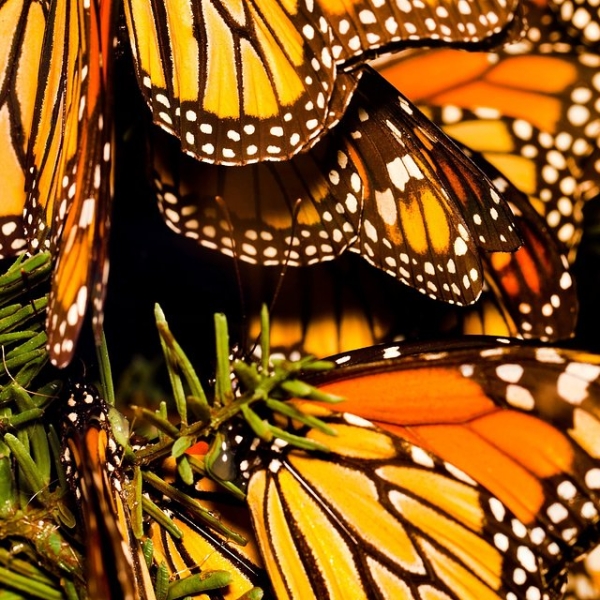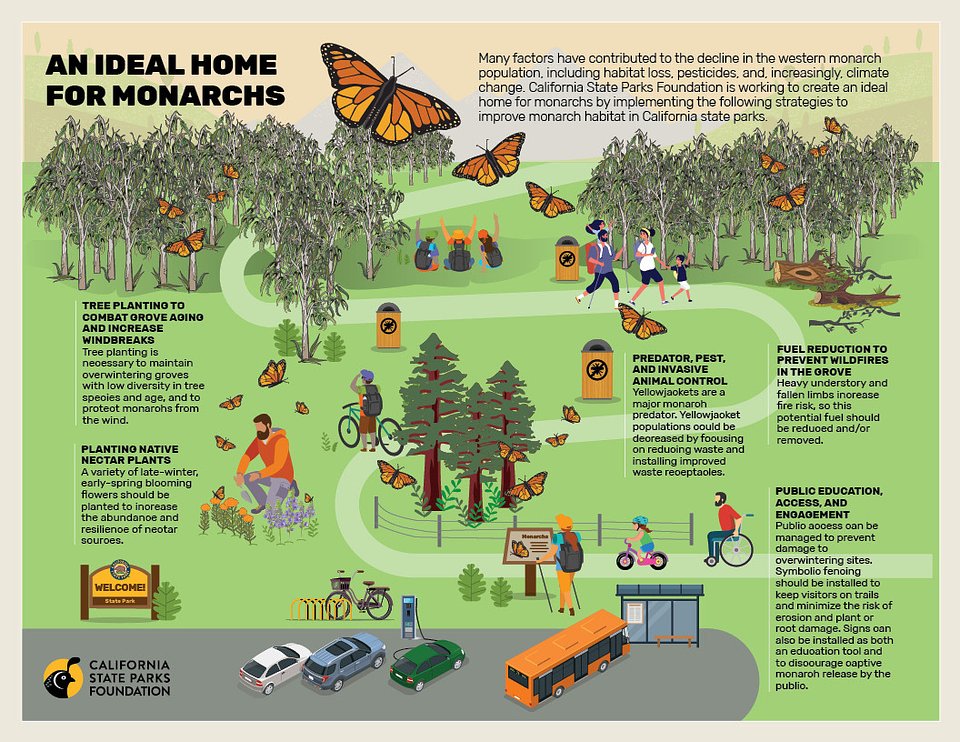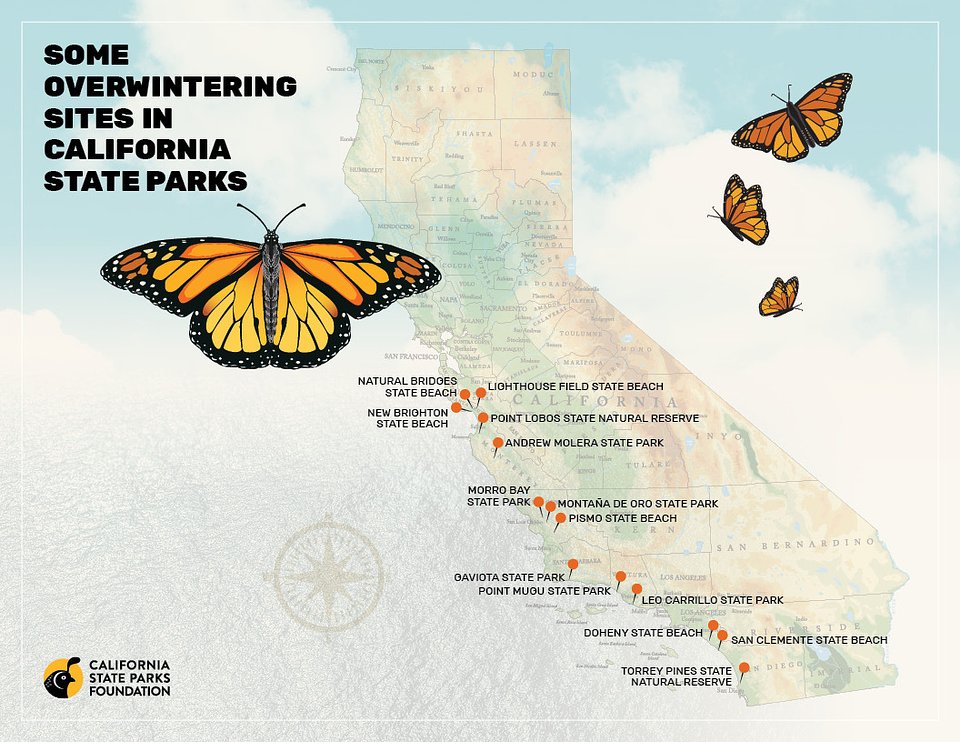27 February 2023
California State Parks Foundation grants $50,000 to help parks plan for and protect western monarch butterfly habitat.
California State Parks Foundation takes a comprehensive approach to protecting western monarch butterflies by funding projects that protect key habitats, organizing volunteer workdays, supporting legislation to protect them, and providing accessible education. Most recently, California State Parks Foundation provided $50,000 to fund overwintering grove management plans in three California state parks through the 2023 Western Monarch Butterfly Conservation Grant Round.
The population of western monarch butterflies has significantly declined in the past two decades. Those overwintering along the California coast have fallen from an estimated 4.5 million butterflies in the 1980s to only 1,899 in 2020. The past two years have shown an encouraging population rebound, but monarchs are still threatened. U.S. Fish & Wildlife Service reported that the monarch butterfly “warranted listing as an endangered or threatened species under the [Endangered Species] Act, but that listing was precluded by higher priority listing actions,” and in July 2022 the species was listed as endangered on the IUCN Red List.
Every winter, western monarch butterflies return to California to spend the season at coastal overwintering sites. These sites provide the specific habitat that overwintering monarchs need to survive. An ideal home for monarchs includes dappled sunlight, high humidity, fresh water, and the absence of freezing temperatures or high winds. This is a vulnerable stage in a monarch’s life cycle, so protecting their habitat with overwintering grove management plans is critical.
Overwintering grove management plans outline how land stewards can maintain overwintering groves to protect essential monarch habitat. Plans must also consider changing climate conditions and how threats like sea level rise may affect groves, now and in the future. Management strategies include:
-
Planting trees to provide shelter from heavy winds
-
Removing wildfire threats near overwintering groves
-
Planting native flowering plants as nectar sources
-
Managing risks from predators, pests, and diseases
-
Educating and engaging the public and ensuring they have access to parks
In 2022, California State Parks Foundation funded three grants totaling $62,642 to help create overwintering grove management plans, plant native nectar plants, and educate park visitors at Lighthouse Field State Beach, Natural Bridges State Beach, San Simeon State Park, and Pismo Beach State Park.
This year, California State Parks Foundation will provide even more funding to ensure western monarch butterflies are protected with sustainable future planning. In 2023, California State Parks Foundation is excited to fund two organizations creating overwintering grove management plans in the Santa Cruz and San Luis Obispo Coast Districts through the 2023 Western Monarch Butterfly Conservation Grant Round.
Groundswell Coastal Ecology — $24,999.33
Groundswell Coastal Ecology recently authored two plans, one for Natural Bridges State Beach and an update for Lighthouse Field State Beach. The recent 2022–2023 winter storms caused widespread devastation to many California state parks, including monarch overwintering grove habitat at both state beaches. These plans identify several actions to increase the resilience of overwintering monarch populations. Actions include assessing storm damage, downed trees, erosion, and damaged structures; clearing dead and downed trees; replanting trees to replace recently lost trees; and mitigating flooding in the Natural Bridges State Beach overwintering grove.
California State Parks San Luis Obispo Coast District — $24,972.20
This project will protect, maintain, and improve two overwintering sites within Morro Bay State Park. Specifically, it will focus on planting native nectar plants to ensure a sufficient food supply, planting trees to add biodiversity and wind protection, and removing downed trees and debris to reduce wildfire risk and create a more favorable microclimate for overwintering monarchs. Additionally, state parks will mark trees and areas where monarchs cluster to track and document monarch cluster preferences and tree health throughout the season.
Overwintering grove management plans are a great way for parks and nonprofits to protect western monarch butterflies, but there are also many ways that individuals can take action, such as planting native plants that support western monarch butterflies’ life cycles and needs. However, it is important to know which plants are beneficial and how to plant them. For example, western monarchs lay their eggs on milkweed, so it must be planted at least five miles from the coast to encourage normal migration patterns between breeding grounds and overwintering sites. It is also important to stick to native varieties like narrow-leaved milkweed, showy milkweed, and California milkweed, and to avoid planting tropical milkweed, which can harbor a harmful parasite. Those who want to get involved can plant native wildflowers like pacific aster, California goldenrod, and coyote brush, which are all nectar sources for western monarch butterflies along their migration paths throughout California.
Support for the 2023 Western Monarch Butterfly Conservation Grant Round was generously provided by our California State Parks Foundation members and donors.
Contacts
Ashley Tittle
Director of Marketing and Communications at California State Parks Foundation
ashley@calparks.org
415-262-4428
Randy Widera
Director of Philanthropy at California State Parks Foundation
randy@calparks.org
831-334-0372


